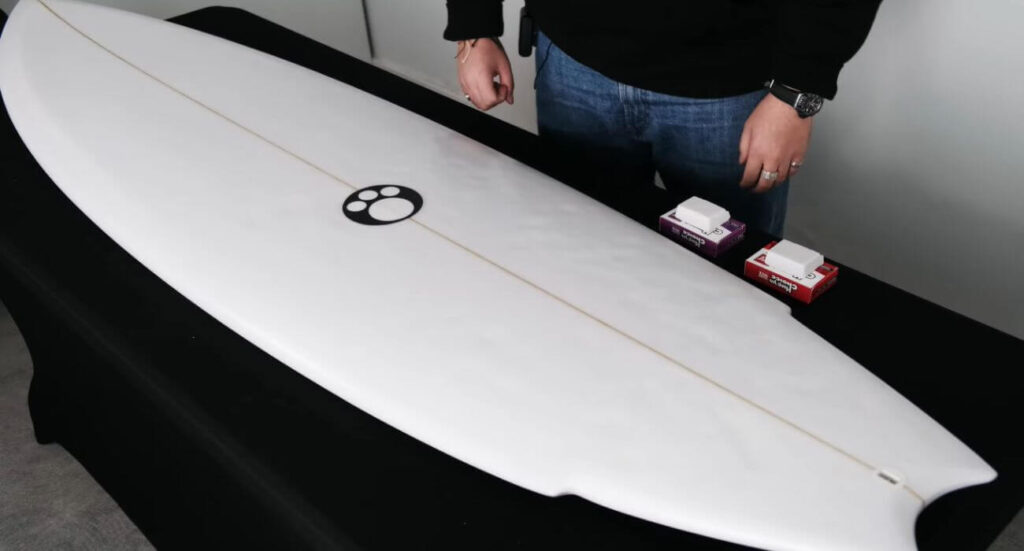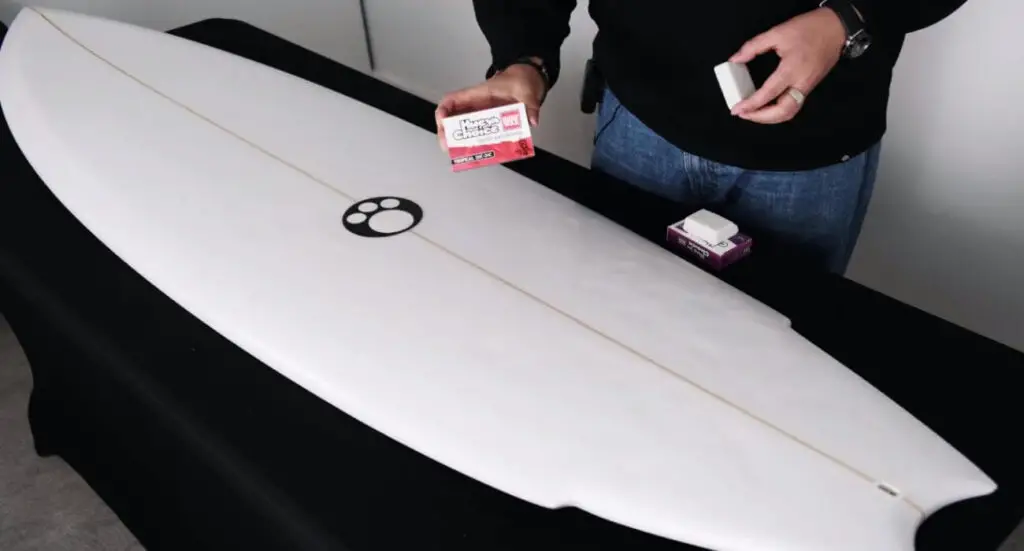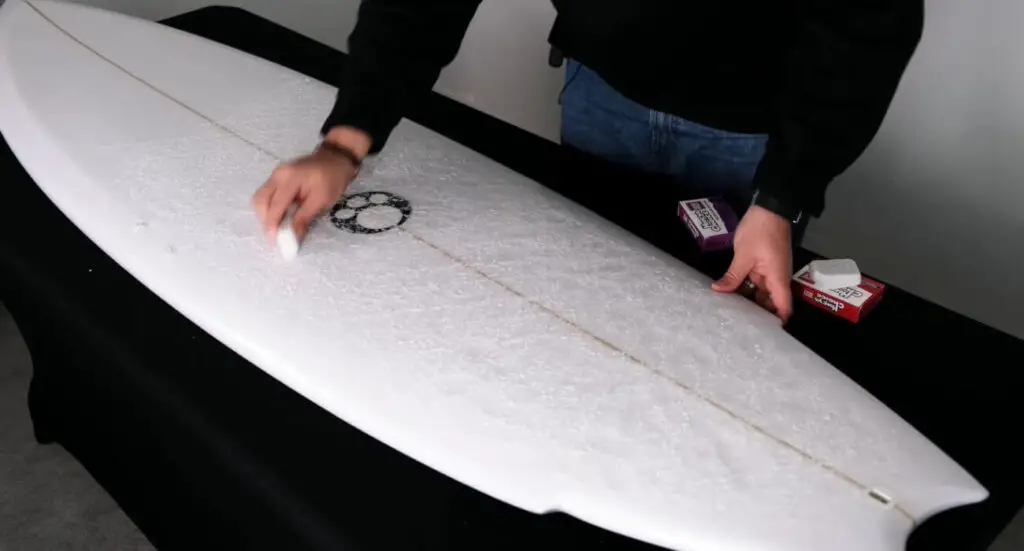As an Amazon Associate, I earn from qualifying purchases
To wax a surfboard, start by applying a base coat of wax using horizontal strips from the nose to the tail. Then, apply a topcoat of wax in a criss-cross pattern for added traction.
Introduction To Surfboard Waxing
Surfboard waxing is a crucial step in maintaining the performance and grip of your surfboard. Whether you are a beginner or an experienced surfer, keeping your board properly waxed is essential for maximizing your traction and control while riding the waves.
Why Waxing Is Important
Waxing your surfboard serves two main purposes. Firstly, it creates a textured surface that helps you maintain grip and traction on your board. Without wax, your feet would easily slip off the smooth fiberglass surface, making it challenging to balance and maneuver effectively.
Secondly, surfboard wax helps to protect the board’s surface from damage caused by the elements, such as sun exposure and water absorption. Regular waxing adds a protective layer on the board, preventing premature wear and tear and extending its lifespan.
Types Of Wax For Different Water Temperatures
Not all surfboard waxes are created equal. The type of wax you choose depends on the water temperature you’ll be surfing in. Using the right wax for the specific water conditions ensures optimal grip and performance.
Here are the different types of surfboard wax based on water temperature:
| Water Temperature | Recommended Wax |
|---|---|
| Warm (above 68°F or 20°C) | Warm/tropical wax (soft) |
| Moderate/cool (58-68°F or 14-20°C) | Cool water wax (medium) |
| Cold (below 58°F or 14°C) | Cold water wax (hard) |
Using the appropriate wax for the water temperature ensures the wax retains its grip and consistency, allowing you to maintain control over your board in various conditions.
Now that you understand the importance of surfboard waxing and the different types of wax available, it’s time to learn the step-by-step process of how to wax a surfboard. Stay tuned for our next blog post!
Step-by-step Guide To Waxing A Surfboard
Learn how to wax a surfboard like a pro with this step-by-step guide. From choosing the right wax to applying it in a criss-cross pattern, you’ll have your board ready for the waves in no time.
Preparing The Board

Before you begin waxing your surfboard, it’s important to prepare the board properly. Start by cleaning the board thoroughly with fresh water to remove any dirt, salt, or sand. Use a soft cloth or sponge to gently scrub the surface of the board. Make sure to dry the board completely before proceeding to the next step.
Choosing The Right Wax

The next step is to choose the right wax for your surfboard. The type of wax you use will depend on the water temperature you’ll be surfing in. Cold water wax is softer and stickier, while warm water wax is harder and less sticky. To ensure maximum grip, it’s essential to match the wax with the water temperature. Read the labels on the wax packaging to determine which one is suitable for your surfing conditions.
Applying The Wax

Once you have your wax and board prepared, it’s time to apply the wax. Start by applying the base coat wax. This will provide a foundation for the topcoat wax to adhere to and extend its lifespan. Use long, smooth strokes to apply the base coat wax across the entire deck of the surfboard. Make sure to cover all areas evenly.
After applying the base coat, it’s time to apply the topcoat wax. Start at the tail of the board and work your way towards the nose. Use circular motions to rub the wax onto the board until it starts to form small beads. This indicates that the wax is properly adhering to the surface.
As you apply the wax, it’s important to create a criss-cross pattern with the wax to maximize traction. This pattern allows the wax to create small pockets that grip your feet as you surf. Continue rubbing the topcoat wax until the entire deck of the surfboard is evenly coated.
Tips And Tricks For A Professional Wax Job

Waxing your surfboard is an essential step in ensuring optimal grip and control while riding the waves. A professional wax job not only enhances your performance but also prolongs the life of your board. In this section, we will discuss some valuable tips and tricks to help you achieve a professional wax job.
Maintaining Wax Grip
Having a good grip on your surfboard is crucial for executing maneuvers and maintaining control. Here are some tips to help you maintain wax grip:
- Apply a basecoat wax: Before applying the topcoat wax, it’s advisable to use a basecoat wax. This creates a smooth and sticky surface, allowing the topcoat to adhere better.
- Use the criss-cross method: When applying the topcoat wax, use the criss-cross method. Start by applying horizontal strokes, then switch to vertical strokes. This creates an interlocking pattern that enhances grip.
- Refresh your wax: Over time, wax can wear off or become less sticky. To maintain grip, it’s essential to refresh your wax regularly. You can do this by adding a topcoat layer or using a wax comb to roughen the existing wax.
Removing Old Wax
Before applying a new coat of wax, it’s important to remove the old wax buildup. Here’s a step-by-step guide on how to remove old wax:
- Use a wax comb or wax scraper to scrape off the majority of the wax.
- Apply a wax remover solution to dissolve the remaining wax residue.
- Use a cloth or sponge to wipe away the dissolved wax.
- Rinse the surfboard with water to ensure all traces of wax and wax remover are removed.
- Dry the surfboard thoroughly before applying a new coat of wax.
Common Mistakes To Avoid
While waxing a surfboard may seem straightforward, there are a few common mistakes that can compromise the quality of the wax job. Here are some mistakes to avoid:
- Applying too much wax: Excessive wax can create a slippery film and reduce grip. Apply a moderate amount of wax for optimal results.
- Not removing old wax properly: Failing to remove old wax completely can lead to uneven application and reduced grip. Take the time to remove all traces of old wax before waxing your board.
- Using incompatible waxes: Different surf conditions require different types of wax. Make sure to use a wax suitable for the water temperature and your surfing style.
- Waxing in direct sunlight: Waxing your surfboard in direct sunlight can cause the wax to melt and become messy. Find a shaded area or wax indoors to ensure proper application.
By following these tips and avoiding common mistakes, you can achieve a professional wax job that enhances your performance and ensures a secure grip on your surfboard. So, get out there and enjoy the waves with confidence!
Frequently Asked Questions On How To Wax A Surfboard
What Is The Best Way To Wax A Surfboard?
To wax a surfboard, start with a clean board. Apply a base coat wax if desired. Then, using a wax comb or the edge of the wax, create criss-cross patterns over the board. Apply more wax in a circular motion to build a layer.
Make sure to cover the entire board from nose to tail. Repeat this process whenever needed to maintain grip on your surfboard.
Do You Need A Basecoat Surfboard Wax?
No, you don’t need a basecoat surfboard wax, but it helps the topcoat stick better and makes the wax last longer. Without a basecoat, the topcoat may not adhere properly and can lead to slippery spots on your board. It’s recommended to use basecoat wax until you re-wax your board.
How Do You Put The First Wax On A Surfboard?
To put the first wax on a surfboard, start by applying a light covering of wax and then go over the lines again until they have some relief. Layer a few horizontal strips of wax from the nose to the tail of the board.
This will provide traction while surfing.
How Often Should You Remove Wax From Your Surfboard?
It is recommended to remove wax from your surfboard and do a full cleaning and re-waxing every two to three months. However, if you surf every day and wax your board daily, you may need to clean and re-wax slightly more often per season/year.
Conclusion
To ensure a smooth and enjoyable surfing experience, waxing your surfboard is essential. By following the right techniques and using the appropriate wax, you can maximize your grip and control on the waves. Remember to start with a clean board, apply a base coat for long-lasting results, and use a criss-cross pattern for optimal coverage.
Regular maintenance and reapplication of wax will keep your board in top condition. So grab your wax and get ready to catch some amazing waves!
Read More
1. How to Choose a Surfboard: A Step-by-Step Guide
2. What Size Surfboard Do I Need? The Ultimate Guide
3. What are Surfboards Made of?
4. Paddle Board vs Surfboard: Navigating Your Wave Adventure
As an Amazon Associate, I earn from qualifying purchases

